Ever look at your kitchen scraps and wonder if they could do more than just fill up a trash bin? Well, folks, the answer is a resounding “yes”! In today’s segment of ‘Home-Grown Magic’, grab your gardening gloves because we’re about to make dirt (exciting, huh?), and answer your questions on how to make compost. Are you ready?
The Magic
Understanding the Process
So, you ask, what is this mystical composting process I speak of? Simply put, it’s the natural process of organic matter decomposition. This might sound like a fancy science experiment, but it’s actually just nature’s way of recycling waste. Picture it like a daytime drama for your kitchen scraps: The Orange Peel meets The Coffee Grounds, they mingle with the Fallen Leaves, and a plot twist involving the Paper Shreds happens, and voila – we get a dark, rich treat full of nutrients!
Historical Perspectives
So, who do we thank for this wonderful process? The truth is, it’s is as old as agriculture itself. Early farming societies realized that returning plant and animal waste to the soil improved crop yields. Sir Albert Howard, a British scientist in India in the early 20th century, modernized these traditional methods and developed the “Indore method.” This method, which involves layering different types of waste and regularly turning the pile, is the basis for much of our modern-day techniques. Quite fascinating, isn’t it?
The Science
Here’s where we get a bit geeky. The secret is microorganisms. These tiny life forms break down organic material into humus, the organic component of soil. Bacteria are the leading actors, breaking down the tough cellulose fibers and releasing heat. Fungi and protozoa join in later, and finally, when the pile cools down, larger organisms like earthworms and beetles finish the job. Now, isn’t that an all-star cast?
Reasons to Choose Composting
Why would someone get into it, you might ask? Well, my dear reader, let me count the ways.
Environmental Benefits
First off, composting is a fantastic way to reduce the amount of household waste you produce. Every year, we generate billions of tons of waste, a large portion of which could be transformed instead of ending up in a landfill.
Gardening Benefits
Secondly, mushroom or the ever-popular compost tea, is akin to concocting a ‘vitamin cocktail’ for your plants, as it enriches your soil with all the necessary nutrients. Thirdly, using it lets you witness the fascinating circle of life in your backyard. Are you intrigued yet by the wonders?
Personal and Social Benefits
In addition to the environmental and gardening benefits, it can provide various personal and social benefits. For one, it can be a great educational tool for children, teaching them about nature’s cycles and the importance of sustainability. It can also be therapeutic. There’s something deeply gratifying about playing an active role in nature’s cycle of life and death, turning waste into nutrient-rich soil. You’ll also set a great example for your neighbors, and who knows? You might start a local green revolution!
Ingredients
Green Waste
Now, it’s not as simple as chucking all your waste into a pile and hoping for the best. You need a balanced diet of ‘greens’ and ‘browns’.
Types of Green Waste
What’s green waste, you might ask? Nope, it’s not a pile of shredded dollar bills (although that would be a sight!). Green waste includes vegetable scraps, coffee grounds, fresh grass clippings, and green leaves.
The Role of Green Waste
Greens are high in nitrogen and act as an accelerator, heating up your pile, kind of like adding fuel to a fire. Too much green material, however, and it might look (and smell) more like a swamp monster than a garden enhancer.
Brown Waste
Types of Brown Waste
We have brown waste on the other side of the color spectrum. This includes dried leaves, straw, paper, and wood chips.
The Role of Brown Waste
Browns are high in carbon and help with balancing, like a thermostat controlling the heat from our ‘greens’. They also provide bulk and help with aeration, preventing the pile from becoming a slimy mess. Too much brown material and your pile might just take a nap and refuse to decompose.
Setting Up Your Compost Bin
Setting up your bin is an important decision. Consider it the real estate moment of your journey – location, location, location!
Best Practices for Compost Bin Placement
You’ll want a convenient, well-drained, and partially shaded place to protect your compost from getting too hot or too dry. Having it fairly close to a water source is also a good idea since your pile needs to stay moist (but not too wet!).
Compost Bin Selection
Choosing the Right Bin for Your Needs
Choosing the right compost bin can be a bit like shopping for jeans – it has to fit just right. Your bin should be large enough to generate heat but small enough to turn easily.
DIY Compost Bins: A Cost-Effective Solution
Feeling crafty? DIY compost bins can be made from old pallets, wire fencing, or even a trash can with holes drilled in it. You’ll be saving money and upcycling materials – another win-win!
Steps to Make Compost
Alright, you’ve got your ingredients and your bin; now it’s time to get cooking!
Initial Layering
A Detailed Look at Layering
Layering is crucial. It’s not just about aesthetics or organization; it’s all about creating the right conditions for decomposition. Here, I’ll break down the science behind each layer:
Bottom Layer: Browns
Think of the bottom layer as the foundation of a house. This layer should be composed of coarse brown material like branches and twigs. These materials are rich in carbon, providing energy for the microorganisms to break down your compost.
Why coarse material, you might wonder? The reason is simple: airflow. Air is full of oxygen, which these microorganisms need to survive. The coarse materials create air pockets in the pile, allowing oxygen to circulate. Without sufficient oxygen, you’ll end up with anaerobic decomposition, which is a slower process and produces a rather unpleasant smell.
Middle Layer: Greens
Next up is a layer of green materials. Green materials are high in nitrogen, which microorganisms need to grow and reproduce. You can think of nitrogen as the “protein” in the microorganisms’ diet.
The heat generated in a compost pile primarily comes from the metabolic activity of the microorganisms breaking down the green materials. Therefore, if your compost pile isn’t heating up, it might be because it lacks nitrogen-rich green materials.
Top Layer: Soil or Old Compost
Lastly, a thin soil or old compost layer is added to the top. This layer introduces a diverse community of microorganisms to the pile, kickstarting the decomposition process. It also helps retain heat and moisture in the pile, creating an ideal environment for decomposition.
The Cycle Continues
The process is then repeated, adding layers until your bin is full. With the right mix of materials, the pile will heat up as the microorganisms get to work, breaking down the organic waste into rich, fertile compost. Isn’t it amazing how nature works?
Turning the Compost
Best Practices
Turning your pile is like stirring a giant pot of stew. It ensures that everything cooks evenly, aerates the pile, and accelerates decomposition.
Our Top Picks
FCMP Outdoor IM4000 Dual Chamber Tumbling Composter
Introducing the FCMP Outdoor IM4000 Dual Chamber Tumbling Composter, a proudly Canadian-made composting solution crafted from 100% post-consumer recycled plastic. As the original 8-sided dual chamber tumbling composter, this product offers an innovative approach to composting.
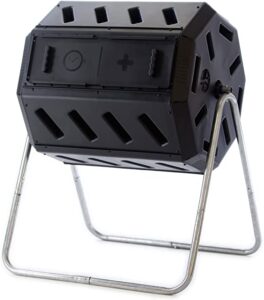
Avoid the labor-intensive process of digging and manually mixing your pile. With this tumbling composter, mixing is effortless and efficient. Just close the door and turn the composter 5-6 times every 2-3 days. Under sunny conditions and with a balanced mix of ingredients, your compost could be ready in as little as two weeks.
The IM4000 is an ideal choice for beginners, featuring large openings and a removable door for easy addition of scraps and clippings and removal of finished compost. Deep fins on the composter body provide ergonomic handholds, making the composting process a breeze.
The power of this composter lies in its dual chambers. The two separate sides allow one side to finish composting while the other remains available for fresh scraps and clippings. This innovative design enables a continuous composting cycle, producing a steady supply of rich, healthy compost. With a generous total capacity of 37 gallons (5 cubic feet), this composter can handle the composting needs of most households.
Superior aeration is another distinguishing feature of the IM4000. All FCMP composter models are equipped with aeration holes and deep fins that break up clumps inside the chamber, thereby introducing lots of oxygen into the compost. This tumbling design ensures far greater aeration than standard composters, promoting quicker and more effective composting.
Durability is a hallmark of this composter’s construction. It’s made from BPA-free, UV-inhibited, 100% post-consumer recycled polypropylene, which is contact-safe and resistant to degradation under direct sunlight. The galvanized steel frame offers excellent corrosion resistance, promising a composting solution that’s built to last.
Choose the FCMP Outdoor IM4000 Dual Chamber Tumbling Composter for a composting experience that’s easy, efficient, and environmentally friendly, all wrapped in a durable, Canadian-made package. Check out Amazon’s best prices here.
Garden Composter Bin Made from Recycled Plastic
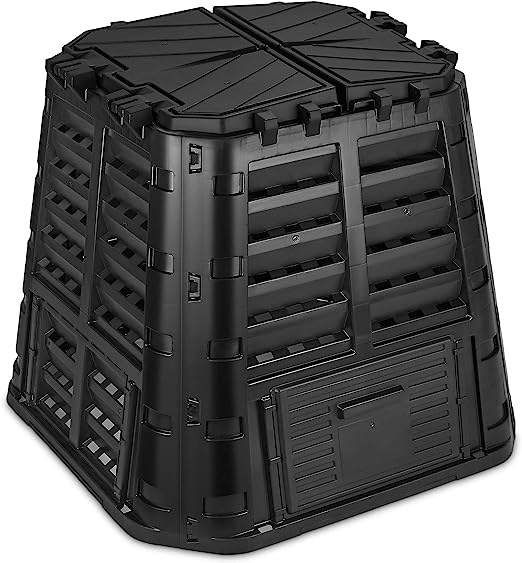
Introducing the Garden Composter Bin by D.F. Omer: a revolutionary tool designed to empower garden enthusiasts, green thinkers, and homegrown food lovers. Experience the joy of crafting your garden paradise with ease and efficiency. This meticulously designed composter bin offers a delightful combination of form and functionality. Let’s take a closer look at what makes this composting solution an essential addition to your backyard.
Cultivate Your Green Thumb: Ever dreamt of rendering nutrient-filled soil for your garden effortlessly? Say goodbye to challenges with D.F. Omer’s composters! Even if you’re new to gardening, our simple process enables you to transform your backyard into a lush paradise. Your green thumb is only a composter away!
Resurrect Your Leftovers: Why throw away kitchen waste when you can give it a new life? Limit your waste and save money with this efficient composting bin. Fill your bin with organic waste, watch it transform into vitamin-enriched soil, and savor the taste of delicious, home-grown produce. It’s sustainability served on a plate!
Made from Premium Recycled Plastic: We believe in the environment as much as you do! This composting bin, constructed with BPA-free recycled black PP plastic, ensures that toxins don’t leach away valuable vitamins. The unique material also maintains heat and regulates moisture, resulting in a shorter composting time. It’s quality you can trust and a step towards a greener planet.
Aeration Station: Composting no longer needs to be a tedious task. Easy to assemble and even simpler to use, D.F. Omer’s composting bins offer a hassle-free experience. No more digging, shoveling, or hand mixing. Plus, with a handy and secure lid, you can rest easy knowing that your food scraps are safe from pesky critters.
In essence, the Garden Composter Bin by D.F. Omer is more than just a composting tool; it’s a lifestyle statement that embodies eco-conscious living and a love for gardening. Whether you’re a seasoned gardener or taking your first step towards sustainable living, this composting solution is designed with you in mind. Elevate your gardening experience and join the green revolution with D.F. Omer today. Get ready to see your garden thrive like never before! Find the best prices on Amazon here.
Dual Chamber Compost Tumbler
Introducing the Dual Chamber Compost Tumbler by Miracle-Gro, designed for those who wish to grow a happier, more lush garden. Give your plants the nutrient-dense fertilizer they crave, and witness your garden bloom like never before! This dual-chamber, heavy-duty tumbling composter features two compartments for efficient composting throughout the year, bringing you one step closer to the garden of your dreams.
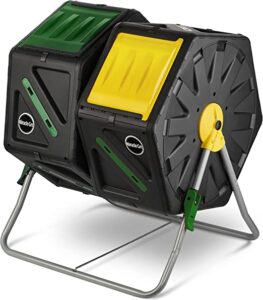
The two-chamber design ensures a constant supply of ready-to-use compost. Add compost ingredients to one side while the other side cures. With internal mixing bars to expedite decomposition, you can expect rich, fertile compost in just 4-6 weeks!
The Dual Chamber Compost Tumbler by Miracle-Gro also makes composting a breeze for beginners and seasoned green thumbs. Say goodbye to heavy lifting, digging, turning, and hand-mixing. Simply open the easy-sliding door, add your scraps, and turn the composter 5-6 times every few days. This efficient tumbler system is the simplest way to achieve perfectly cooked compost.
When you choose Miracle-Gro, you’re choosing a brand that’s trusted by gardeners across America. We stand by the quality of our products and guarantee your satisfaction. Once you start using the compost generated by your new dual-chamber tumbling composter, you’ll notice healthier plants and bigger harvests. Your garden will transform into a sight of beauty, envied by all!
Choose the Dual Chamber Compost Tumbler by Miracle-Gro to make composting effortless, efficient, and rewarding. Grow your happiest garden yet with the power of nutrient-dense compost at your fingertips.
Troubleshooting Common Problems
Problem 1: My Pile is Smelly
A healthy compost pile should have a pleasant, earthy smell. If your pile is producing an unpleasant odor, it’s likely due to one of two reasons:
- Too Much Moisture: A soggy pile can create an anaerobic environment (one lacking in oxygen), leading to slower decomposition and smelly compounds. Solution? Add more brown materials to absorb excess moisture, and ensure your pile is covered in rainy weather to prevent water logging.
- Lack of Aeration: Composting is an aerobic process – it needs oxygen. A pile that isn’t turned regularly can become compacted, limiting the amount of oxygen available to the microorganisms. This can lead to anaerobic decomposition, which produces a foul smell. The solution is simple – get out your pitchfork and give your pile a good turn.
Problem 2: My Pile Isn’t Heating Up
Compost piles heat up due to the activity of microorganisms breaking down organic matter. If your pile isn’t heating up, it might be because:
- Lack of Nitrogen: Microorganisms need nitrogen to reproduce and grow. If your pile isn’t heating up, it could be because you have too many browns (carbon-rich materials) and not enough greens (nitrogen-rich materials). Add more green waste like grass clippings, vegetable scraps, or coffee grounds.
- Insufficient Size: Compost piles need to be of a certain size to retain heat. A pile that is too small will not heat up effectively. Ensure your pile is at least 3 feet high and 3 feet in diameter.
Problem 3: I See Pests!
If you’re seeing pests around your bin, it’s likely because they’re attracted to certain materials:
- Inappropriate Materials: Meat, dairy, and cooked food scraps can attract pests. Stick to plant-based kitchen scraps, yard waste, and appropriate paper products.
- Exposed Compost: If food scraps are not adequately covered by browns, they can attract pests. Ensure you always cover your green materials with a layer of brown materials to deter pests.
Remember, composting is both an art and a science. With time and practice, you’ll learn to manage your pile effectively and avoid these common issues.
Using Your Compost
When is it Ready?
After a few months, your compost should resemble rich, dark soil and smell earthy – a bit like the forest floor. It’s ready to work its magic in your garden!
What to Do if it Isn’t Ready
If it still has identifiable scraps or it’s wet and smelly, it might need more time. Remember, patience is a virtue, and it’s a slow process. Keep turning it, balancing your greens and browns, and nature will do its thing.
Applying to Your Garden
Incorporating into Various Types of Soil
Now comes the moment of truth – using your homemade compost! You can mix it into your garden soil, improving its structure and nutrient content. Whether your soil is sandy, clayey, or somewhere in between, it can help improve its texture, water-holding capacity, and fertility.
Compost Tea: An Extra Treat for Your Plants
Feeling extra generous? Make your plants a ‘compost tea’ by steeping compost in water and using it to water them. It’s like a nutrient-packed smoothie for your green friends!
Conclusion
So, dear reader, you now hold the secret to turning your waste into ‘black gold’. It’s a win-win situation – less trash, more lush, healthy plants. Composting is a rewarding, eco-friendly hobby that truly embodies the saying, “One man’s trash is another man’s treasure.” Now, go forth and get busy!
Frequently Asked Questions
What can I compost?
Most organic waste such as vegetable scraps, coffee grounds, leaves, and paper.
What should I not compost?
Avoid meat, dairy, diseased plants, and pet waste, as these can attract pests or create unpleasant odors.
How long does it take?
Depending on your method and materials, it can take anywhere from 2 months to a year.
Does it smell?
When done properly, it should not smell bad. If it does, it might be too wet or lacking in oxygen.
Can I compost in winter?
Yes, but the process slows down due to cold temperatures.

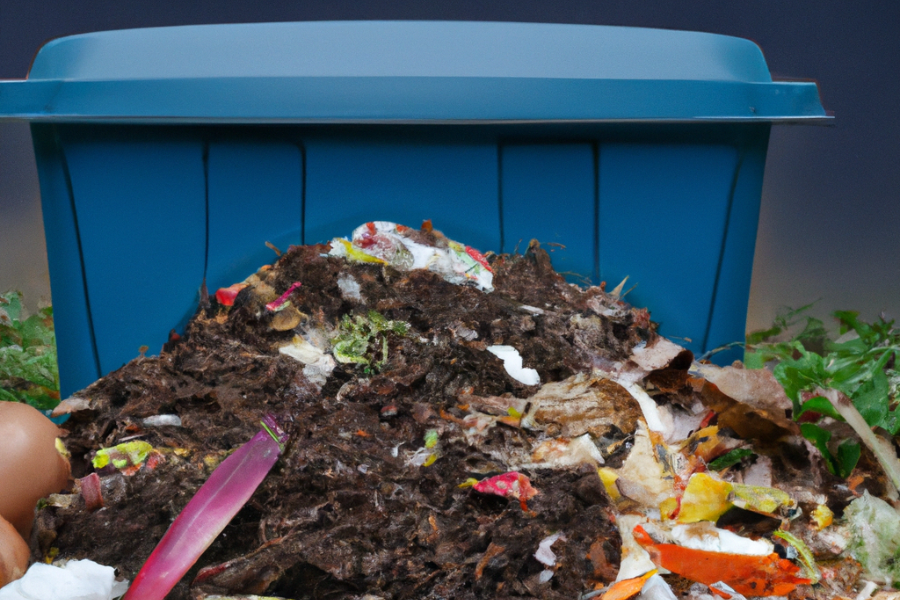

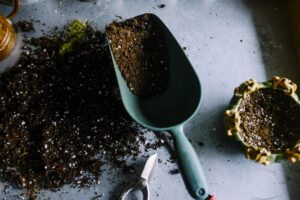

Pingback: Composting Worms: The Unsung Heroes of Your Garden *
Pingback: Mushroom Compost: Care for Some Black Gold? - Eco Life Wise
Pingback: Benefits of Composting: A Complete Guide | Eco Life Wise
Pingback: DIY Compost Bin: Master the Art of Composting in Your Backyard | Eco Life Wise
Pingback: Compost Spreader: You and Your Garden's Best Friend
Pingback: Permaculture Garden: Create Your Own Eco-Friendly Haven! | Eco Life Wise
Pingback: How Do Self-sustaining Homes Manage Water And Waste? 10 Important Factors | Eco Life Wise